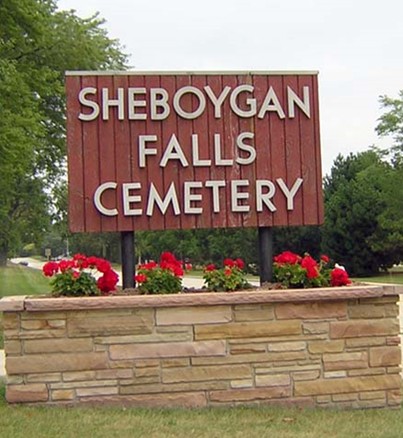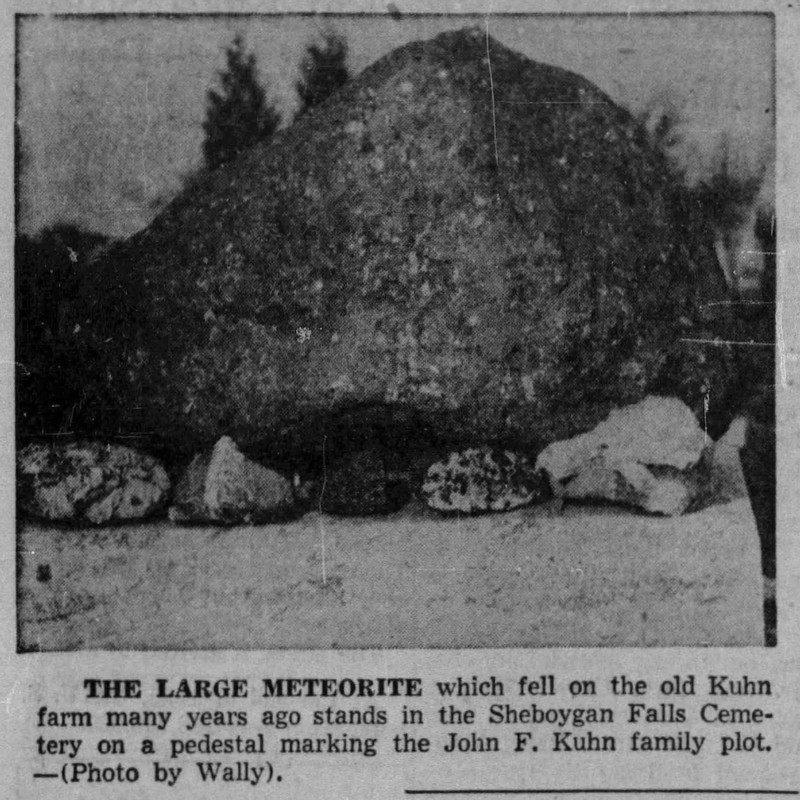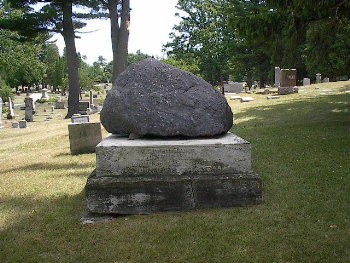John F. Kuhn's Meteorite
Introduction
Text-to-speech Audio
As you walk through the Sheboygan Falls cemetery, you will come across an unusual grave marker. This large stone marks the grave of John F. Kuhn, who claimed that the stone was a meteorite from space. Although that claim has not been officially confirmed, it is quite possibly true. Even if it isn't, the stone makes an impressive memorial and contributes to the landscape of this beautiful cemetery.
Images


Meteorite Marker

Backstory and Context
Text-to-speech Audio
This average farmer has become famous across the country, and not for his amazing agricultural skills…but for his headstone. This stone is 4.5 feet long and 3 feet wide, and Mr. Kuhn claims that it fell from outer space.
John Kuhn thought ahead about how he wanted to be buried. He claimed that this meteorite fell on his farm which was located along Highway 23 between Falls and Plymouth sometime in the late 1870s or early 1880s. Kuhn hauled the stone to the Sheboygan Falls Cemetery with a team of horses and placed it here on the family lot. After Kuhn’s death in 1884, the stone was attached to this pedestal with an inscription on one side that says “In memory of John F. Kuhn, who died in 1884” and “The surmounted specimen was selected by Mr. Kuhn and is placed here in compliance with his request” on the other.
It has not been officially proven that it is or is not a meteor from outer space. A distinct characteristic of a meteorite though is its weight. They weigh significantly more than regular stones because of the iron they contain. We don’t have a way to weigh it without disturbing the burial sight – but the fact that it took him a full team of horses to pull this to the cemetery is a good indication that it is heavy!
Until 1969, there were only about 2,000 meteorites in the world’s collections. Meteors typically burn up in the earth’s atmosphere and never make it to the ground. If this truly is a real meteorite, it is a rare and unique find! This unique headstone marker is a bluish, dark gray smooth stone with molten rust and black specks, and crystal-like lumps of varying shades of gray throughout it. The fact that it is smooth is surprising since from the look of it, you would expect it to be bumpy. Go ahead, touch it! We know you want to.
Since 1884, visitors have come from all over the country to see the meteor. It is also listed as a meteorite sight to visit online for space enthusiasts.
John F. Kuhn was born in Germany in 1829. He immigrated to America and arrived in New York in August 1867 at the age of 38. He quickly made his way to Wisconsin and applied for Naturalization in the Oshkosh area on November 5, 1867. He later received his citizenship on September 14, 1882. By the 1870 census he was living in Sheboygan Falls with his wife Lydia A. Kuhn, and they operated a farm. Although, John Kuhn was just an average man, he discovered something extraordinary and will go down in history for having a (so far) undisputed meteorite as his tombstone.
Is it weird that we added a stop in a cemetery? Not at all! Although often seen today as dark and something to be avoided, rural cemeteries were once a place to enjoy nature and the company of friends and family. Organized rural cemeteries did not exist in America until Mount Auburn Cemetery was constructed in Cambridge, Massachusetts in 1831. This large, park like cemetery concept had never before been seen in the U.S., which as of yet did not have public parks, nature preserves, art museums or botanical gardens. Soon rural cemeteries were developing all over the country, and citizens flocked to these new “parks.” Located on the outskirts of cities and towns, rural cemeteries provided escape from the hustle and bustle of noisy, everyday life.
Today, cemeteries can be considered open air museums full of art, history, stories, nature, wildlife, and gardening. Visitors can discover local history in a way that brings it to life. Benjamin Franklin said, “Show me your cemeteries and I will tell you what kind of people you have.” There are approximately 110 church-affiliated and independent cemeteries in Sheboygan County. So grab the picnic basket and make a date to explore the cemeteries!
The Town of Rochester’s first cemetery did not emerge until nine years after settlers first arrived. Dorothy Chapin, wife of Deacon William Trowbridge died January 1, 1844 and became the first to be buried in the cemetery that was surrounded by Adams, Hickory, and Jackson Streets. This spot overlooking the Onion River and Sheboygan River continued to be the location for pioneer burials until the newly renamed Town of Sheboygan Falls bought 8.5 acres of land from Silas Stedman (buried in this cemetery) for $400 in 1854. Over the years paved roads, trees and landscaping, and water piped in from the Village of Kohler system have been added and maintained. The Village of Kohler Cemetery is located directly north of this cemetery. The Sheboygan Falls Cemetery is a city run cemetery and attended to by the Sheboygan Falls Public Works Department.
Sources
Dippel, Beth. Beth Dippel: Sheboygan County cemeteries boast distinctive personalities, The Sheboygan Press. December 8th, 2017. Accessed December 1st, 2023. https://www.sheboyganpress.com/story/news/2017/12/08/sheboygan-county-historical-research-center-even-though-cemeteries-share-same-purpose-their-personal/934639001/.
Dippel, Beth. History Uncovered: Sheboygan's earliest cemeteries, The Sheboygan Sun. November 23rd, 2022. Accessed December 1st, 2023. https://www.sheboygansun.com/history/history-uncovered-sheboygans-earliest-cemeteries/article_965ba20a-6a7b-11ed-be5a-6b578ab1becf.html.
The Sheboygan Press from Sheboygan, Wisconsin • Page 13, Newspapers.Com. December 11th, 1988. Accessed December 1st, 2023. https://sheboyganpress.newspapers.com/newspage/241222889/.
